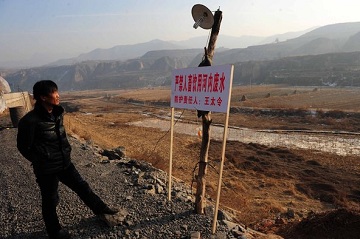Worse Than Poisoned Water: Dwindling Water, in China's North
 BEIJING — When 39 tons of the toxic chemical aniline spilled from a factory in Changzhi in China’s Shanxi province at the end of December, polluting drinking water for hundreds of thousands of people downstream along the Zhuozhang River and dangerously fouling the environment, it seemed a grave enough disaster. And it was.
BEIJING — When 39 tons of the toxic chemical aniline spilled from a factory in Changzhi in China’s Shanxi province at the end of December, polluting drinking water for hundreds of thousands of people downstream along the Zhuozhang River and dangerously fouling the environment, it seemed a grave enough disaster. And it was.So it’s hard to believe, perhaps, but in mid-January, just days after local officials belatedly revealed the spill to the public, a “rapid response team” sent by Greenpeace China to investigate found something even worse than the spill, the blogger Zhou Wei wrote in chinadialogue, an online magazine about China’s environment. Greenpeace found that the fast pace of water consumption by coal and chemical industries in the area is drying up all water resources further downstream. In fact, by 2015, water consumption by coal and chemical industry in China’s dry, western areas is set to use up a whopping quarter of the water flowing annually in the nearby Yellow River, which forms much of the border of Shanxi Province and is popularly known as China’s “Mother River,” wrote chinadialogue.
As chinadialogue wrote, citing Greenpeace, “Even more worrying than the chemical leak is the high water consumption of the coal and chemical industries in the area.”
The blog post, which chinadialogue says hasn’t been translated into English yet, cited Tong Zhongyu of Greenpeace’s East Asia office as saying that the situation was “growing more severe by the day.”
None of this may be news to hardened followers of China’s crumpling environment, but the scale of the water consumption in the water-scarce area is nonetheless shocking: The Tianji Coal Chemical Industry Group, which caused the spill, consumes water equivalent to the consumption of about 300,000 people per year, chinadialogue wrote, citing the Greenpeace investigation.
The coal and chemical industry is simply “a major water-eater,” the post said.
Water is a key challenge for the country as the racing economy guzzles it faster and faster. In the last 40 years, 13 percent of China’s lakes have disappeared, half its coastal wetlands have been lost to reclamation and 50 percent of cities left without drinking water that meets acceptable hygienic standards, the World Wildlife Fund said, according to another article in chinadialogue. The United Nations has singled China out as one of 13 countries with extreme water shortages.
“By any measure, the situation is bleak,” chinadialogue said. For now, the government is split between small-scale, practical solutions to the problem and huge engineering projects, such as the South-North water diversion scheme, which aims to transfer water from the rainy south to the dry north but has been widely criticized by environmentalists as too big, inefficient and ultimately unworkable.
“My heart is really out for the leadership trying to come up with solutions because China’s just so maddeningly complex,” Michael Bennett, an environmental economist, was quoted as saying. As evidence of serious efforts to solve the problem, Mr. Bennett pointed to widespread, small-scale, government-approved water conservation programs taking place around the country.
Will China solve its really serious water problems?
“The trend is in the right direction, the question is whether it’s going to be fast enough,” Mr. Bennett said.
You can return to the main Market News page, or press the Back button on your browser.

